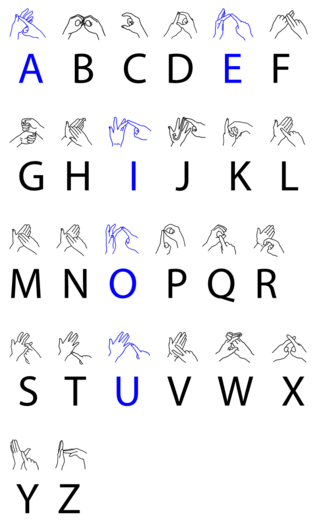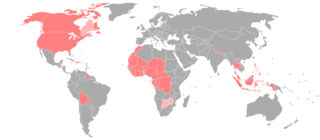
American Sign Language (ASL) is a natural language that serves as the predominant sign language of Deaf communities in the United States and most of Anglophone Canada. ASL is a complete and organized visual language that is expressed by employing both manual and nonmanual features. Besides North America, dialects of ASL and ASL-based creoles are used in many countries around the world, including much of West Africa and parts of Southeast Asia. ASL is also widely learned as a second language, serving as a lingua franca. ASL is most closely related to French Sign Language (LSF). It has been proposed that ASL is a creole language of LSF, although ASL shows features atypical of creole languages, such as agglutinative morphology.

Fingerspelling is the representation of the letters of a writing system, and sometimes numeral systems, using only the hands. These manual alphabets have often been used in deaf education and have subsequently been adopted as a distinct part of a number of sign languages. There are about forty manual alphabets around the world. Historically, manual alphabets have had a number of additional applications—including use as ciphers, as mnemonics and in silent religious settings.

Sign languages are languages that use the visual-manual modality to convey meaning, instead of spoken words. Sign languages are expressed through manual articulation in combination with non-manual markers. Sign languages are full-fledged natural languages with their own grammar and lexicon. Sign languages are not universal and are usually not mutually intelligible, although there are also similarities among different sign languages.

British Sign Language (BSL) is a sign language used in the United Kingdom and is the first or preferred language among the deaf community in the UK. While private correspondence from William Stokoe hinted at a formal name for the language in 1960, the first usage of the term "British Sign Language" in an academic publication was likely by Aaron Cicourel. Based on the percentage of people who reported 'using British Sign Language at home' on the 2011 Scottish Census, the British Deaf Association estimates there are 151,000 BSL users in the UK, of whom 87,000 are Deaf. By contrast, in the 2011 England and Wales Census 15,000 people living in England and Wales reported themselves using BSL as their main language. People who are not deaf may also use BSL, as hearing relatives of deaf people, sign language interpreters or as a result of other contact with the British Deaf community. The language makes use of space and involves movement of the hands, body, face and head.
Auslan is the sign language used by the majority of the Australian Deaf community. The term Auslan is a portmanteau of "Australian Sign Language", coined by Trevor Johnston in the 1980s, although the language itself is much older. Auslan is related to British Sign Language (BSL) and New Zealand Sign Language (NZSL); the three have descended from the same parent language, and together comprise the BANZSL language family. Auslan has also been influenced by Irish Sign Language (ISL) and more recently has borrowed signs from American Sign Language (ASL).

New Zealand Sign Language or NZSL is the main language of the deaf community in New Zealand. It became an official language of New Zealand in April 2006 under the New Zealand Sign Language Act 2006. The purpose of the act was to create rights and obligations in the use of NZSL throughout the legal system and to ensure that the Deaf community had the same access to government information and services as everybody else. According to the 2013 Census, over 20,000 New Zealanders know NZSL.
Hawaiʻi Sign Language or Hawaiian Sign Language, also known as Hoailona ʻŌlelo, Old Hawaiʻi Sign Language and Hawaiʻi Pidgin Sign Language is an indigenous sign language native to Hawaiʻi. Historical records document its presence on the islands as early as the 1820s, but HSL was not formally recognized by linguists until 2013.
Manually Coded English (MCE) is a type of sign system that follows direct spoken English. The different codes of MCE vary in the levels of directness in following spoken English grammar. There may also be a combination with other visual clues, such as body language. MCE is typically used in conjunction with direct spoken English.
A contact sign language, or contact sign, is a variety or style of language that arises from contact between deaf individuals using a sign language and hearing individuals using an oral language. Contact languages also arise between different sign languages, although the term pidgin rather than contact sign is used to describe such phenomena.

Mexican Sign Language, is a natural language that serves as the predominant language of the Deaf community in Mexico. LSM is a complete and organized visual language, which is expressed with the hands, face, and body, with its own distinct history, community, and culture. There are several dialects based on regional variation and LSM may be learned as a second language by hearing and Deaf signers. LSM is closely related to French Sign Language (LSF) and American Sign Language (ASL), although it is mutually unintelligible.
American Sign Language (ASL), the sign language used by the deaf community throughout most of North America, has a rich vocabulary of terms, which include profanity. Within deaf culture, there is a distinction drawn between signs used to curse versus signs that are used to describe sexual acts. In usage, signs to describe detailed sexual behavior are highly taboo due to their graphic nature. As for the signs themselves, some signs do overlap, but they may also vary according to usage. For example, the sign for "shit" when used to curse is different from the sign for "shit" when used to describe the bodily function or the fecal matter.
The French Sign Language or Francosign family is a language family of sign languages which includes French Sign Language and American Sign Language.
The Swedish Sign Language family is a language family of sign languages, including Swedish Sign Language, Portuguese Sign Language, and Finnish Sign Language.
In sign languages, the term classifier construction refers to a morphological system that can express events and states. They use handshape classifiers to represent movement, location, and shape. Classifiers differ from signs in their morphology, namely that signs consist of a single morpheme. Signs are composed of three meaningless phonological features: handshape, location, and movement. Classifiers, on the other hand, consist of many morphemes. Specifically, the handshape, location, and movement are all meaningful on their own. The handshape represents an entity and the hand's movement iconically represents the movement of that entity. The relative location of multiple entities can be represented iconically in two-handed constructions.

Black American Sign Language (BASL) or Black Sign Variation (BSV) is a dialect of American Sign Language (ASL) used most commonly by deaf African Americans in the United States. The divergence from ASL was influenced largely by the segregation of schools in the American South. Like other schools at the time, schools for the deaf were segregated based upon race, creating two language communities among deaf signers: black deaf signers at black schools and white deaf signers at white schools. As of the mid 2010s, BASL is still used by signers in the South despite public schools having been legally desegregated since 1954.

American Sign Language (ASL) developed in the United States, starting as a blend of local sign languages and French Sign Language (FSL). Local varieties have developed in many countries, but there is little research on which should be considered dialects of ASL and which have diverged to the point of being distinct languages.
John Smith is a British comedian, actor and performer. He is deaf and a British Sign Language user.

A nonmanual feature, also sometimes called nonmanual signal or sign language expression, are the features of signed languages that do not use the hands. Nonmanual features are gramaticised and a necessary component in many signs, in the same way that manual features are. Nonmanual features serve a similar function to intonation in spoken languages.
Australian Irish Sign Language or AISL is a minority sign language in Australia. As a Francosign language, it is related to French Sign Language as opposed to Auslan which is a Banzsl language which is related to British Sign Language. AISL was brought to Australia from Ireland in 1875 by a group of Dominican nuns where three schools were established and used AISL as a language of instruction. Due to oralist policies, the use of AISL was discontinued as a language of instruction in the early 1950s. There are now around 100 signers of this language, most of who are in their early seventies and onwards, though there may be younger CODAs.









